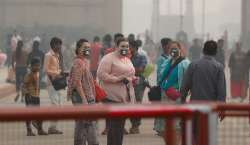India's pollution level expanded; can cut life expectancy by over 9 years: US study
Air quality has significantly worsened in Maharashtra and Madhya Pradesh, Reuters quoted the report's statement.

Life expectancy of nearly 40 per cent of Indians can be cut down by more than nine years, due to air pollution. According to a report released by a US research group on Wednesday, more than 480 million people living in the vast swathes of central, eastern and northern India, including New Delhi, endure significantly high pollution levels.
"Alarmingly, India's high levels of air pollution have expanded geographically over time," said the report prepared by the Energy Policy Institute at the University of Chicago (EPIC).
For example, air quality has significantly worsened in Maharashtra and Madhya Pradesh, Reuters quoted the report's statement.
The report also lauded India's National Clean Air Program (NCAP) and said, "achieving and sustaining" the NCAP goals would raise the country's overall life expectancy by 1.7 years and that of New Delhi 3.1 years."
According to the EPIC's findings, neighbouring Bangladesh could raise average life expectancy by 5.4 years if the country improves air quality to levels recommended by the World Health Organization.
What experts say on smog towers in Delhi
Smog towers may provide immediate relief from air pollution in a small area but they are a costly, quick-fix measure with no scientific evidence to back their long-term benefits, several experts said after the first such structure was inaugurated in Delhi. Government should instead tackle root causes and promote renewable energy to tackle air pollution and reduce emissions, the experts said.
“It will be really unfortunate if other cities decide to follow suit and set up these expensive, ineffective towers. They are an enormous distraction from what should be the governments' focus: reducing emissions,” Santosh Harish, a fellow at the Centre for Policy Research said.
While smog towers might come across as a visible solution to air pollution, there is no scientific evidence -- even globally -- to support that they can filter outdoor air effectively, added Tanushree Ganguly, programme lead at the Delhi-based Council on Energy, Environment, and Water (CEEW).
Their comments came soon after Delhi Chief Minister Arvind Kejriwal inaugurated India’s first smog tower in the city’s Connaught Place area last month. The government claimed it will purify 1,000 cubic meters of air per second within a radius of around one kilometre.
Kejriwal said the over 24-meter tall structure, the first of its kind in India, has been set up as a pilot project and initial trends will be available within a month.
If the pilot project is successful, more smog towers will be installed in the national capital.
Also Read | High pollution levels increase dementia risk: Study